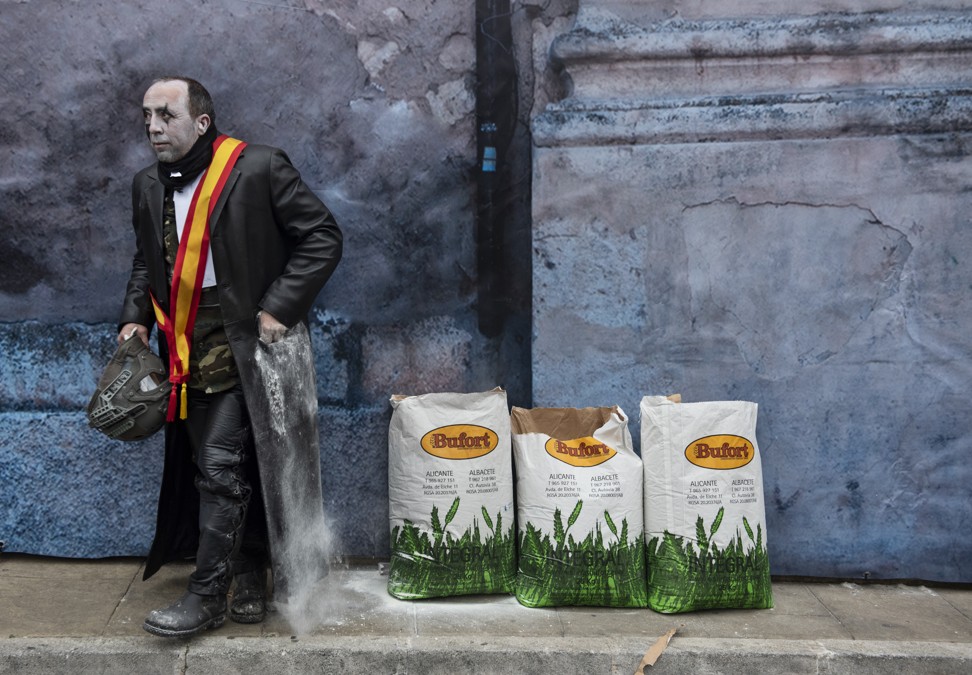
Viva la revolución – the Spanish fiesta that celebrates a coup d’etat that never was
- In the Alicante town of Ibi, all hell breaks lose every December 28 for Els Enfarinats
- As the conflict gathers pace, weapons such as eggs, flour and firecrackers come into play
“Fiesta” is arguably the most widely known Spanish word. And for good reason: Spaniards need little excuse to party. God, the Virgin Mary, a variety of saints and running bulls are all celebrated with gay abandon, but traditional fiestas are being joined by a new breed of secular revelry, celebrating battles and other historical events.
Prominent among the latter is the Tomatina, an all-out war fought with tonnes of tomatoes that breaks out each August in the Mediterranean town of Buñol. This food fight has become so popular that Spanish is the least spoken language among combatants, who each fork out €25 (HK$215) for a ticket, which also includes a glass of bad sangria.
Just 150km to the south of Buñol, however, in the usually sleepy Alicante town of Ibi, an even odder battle takes place, for free and without the crowds, every December 28. Spain’s Fool’s Day is a suitable choice of date, because nothing of any importance ever really happened in Ibi.
Els Enfarinats (“the floured ones” in the Valencian language) is the recreation of a coup d’état that never took place, and is staged amid a riot of flour, eggs and firecrackers, as this writer discovered at last year’s festival.

“We play a group of authoritarian insurgents that manages to overthrow the town’s government for a whole day,” explains the rebels’ (“enfarinats”) leader, Héctor Guillem. “From then on, a series of humorous developments, including a trial of the authorities, escalates into a full blown battle in the streets.”
On the insurgent side are 21 married (or, in the case of Rubén ‘el guaperas’ – “the handsome” – as good as married) men, their faces brightly painted and dressed in mismatched military uniforms, some decorated with fascist insignia. The established order (“la oposició”, the opposition) are a larger group, of single men and women, dressed in black. The first group intends to abuse its newly won power by extorting money from the town residents; la oposició will try to overwhelm the rebels and restore order. They are bound for a violent clash.
“Do not wear flammable textiles,” City Hall notices warn participants. “Cover your whole body to avoid burns”; “Wear a helmet and, if possible, protective glasses”; “Do not participate under the effects of alcohol or drugs.” The final words of warning perhaps best sum up what’s in store: “If you don’t want dust, don’t go to the desert.”
Although the party officially starts on December 28, the enfarinats cannot resist making mischief the day before. They meet for lunch at a bar, Mónaco, and some light firecrackers, called borrachos. These rebels have clearly ignored the advice regarding alcohol and one has to be rushed to hospital after a borracho explodes in his trousers. He can’t remember how it got there.
Others play it safer and adopt flour as their weapon. That evening, enfarinats draw a zebra crossing across a road with flour and make cars stop. Most drivers play along and laugh, but not everybody is happy; one complains about the noise and the mess that’s been made before the festival has even officially started.
The night is long and many of the insurgents prepare to do battle the next morning without having had any sleep.

Soon after 6am, while darkness still reigns, two facepainters arrive at Mónaco to turn the rebels into Braveheart-style warriors. Guillem chooses to have the right half of his face painted green and the left yellow, with two white circles around his eyes; others go for the crimson and yellow of the Spanish flag while the colours of the German standard are popular.
At around 9am, the rivals meet in front of the church and hostilities commence with a 200-metre race to City Hall, although tradition dictates that only the leader of the enfarinats can win, thus symbolising the overthrow of the government. The mayor is forced to hand power to Guillem.
After the new order has been established, the enfarinats demand taxes from businesses and onlookers. Those who refuse to pay are met with firecracker fury, but this dictatorial behaviour will be the spark that ignites white-and-yellow pandemonium.
At 10am, battle is joined, both sides flinging flour and eggs, hoping to blind their enemies and make them fall. The aggression builds slowly, eggs being thrown one at a time, but soon escalates until full trays of 24 are being hurled. Unauthorised weapons, such as fire extinguishers, are not uncommon.

“People end up throwing anything they can find,” explains Guillem, barely recognisable under a coat of flour. “Only objects that can harm participants and liquids are banned. It’s cold, so if you get wet you may end up with a pneumonia.”
At 11am, all hell breaks loose, firecrackers now being introduced to the fray. And in the Valencia region,borrachos come only in sizes suitable for mass destruction. Running away is no longer an option because the ground has become so slippery that even staying on one’s feet is a challenge.
“Nobody really knows where the origins of this festivity lie,” says Guillem. “[In City Hall], we found one of the orders mayors used to read at the town’s square three centuries ago, in which a carnivalesque festivity of two factions in conflict is mentioned.
“However, at that time, the enfarinats were called amantats, because they wrapped themselves in blankets to fend off the cold, and they just used to publicly criticise what they believed the government had done wrong that year. We still carry on with this tradition, singing in verse the day before the fight, but there is no evidence of a staged battle happening until two centuries ago.”

In the 1950s, the enfarinats were outlawed, being deemed too subversive by the Franco dictatorship; humour was not the regime’s strong point. It wasn’t until 1981, six years after the death of the generalísimo and three after the nation’s democratic constitution was passed, that the townsfolk of Ibi reinstated the celebration.
“I’ve seen the party since I was a child,” says Guillem. “I used to watch in awe these bizarre characters. Sometimes I was even scared.”
Women are permitted to take part but none is allowed to join the enfarinats while just one is seen among la oposició. In the “MeToo” era, men-only traditions are coming under close scrutiny, and the organisers of some Spanish celebrations, such as the parade in the Basque city of Hondarribia held in September to commemorate victory over the French, encourage women to take part.
Throwing around food could be seen as an example of wastefulness, but all the flour and eggs used are past their sell-by date – the truth of that claim is there for everyone to smell – and money extorted by the insurgents is donated to charity.

Back on the streets, there is an emotional pause before the final battle: Ramón Mida, an enfarinat for 14 years, died recently of a heart attack and his sons have decided to scatter his ashes along with the flour. That’s what he would have wanted, they say.
War ends a little after 2pm, in time for a meal and more alcohol. Women do take part in the peaceful and folkloric afternoon frivolities, albeit with their faces covered. They may show themselves only during the last dance of the day, an event that marks the end of the uprising and the restoration of the government. At least for another 12 months.

